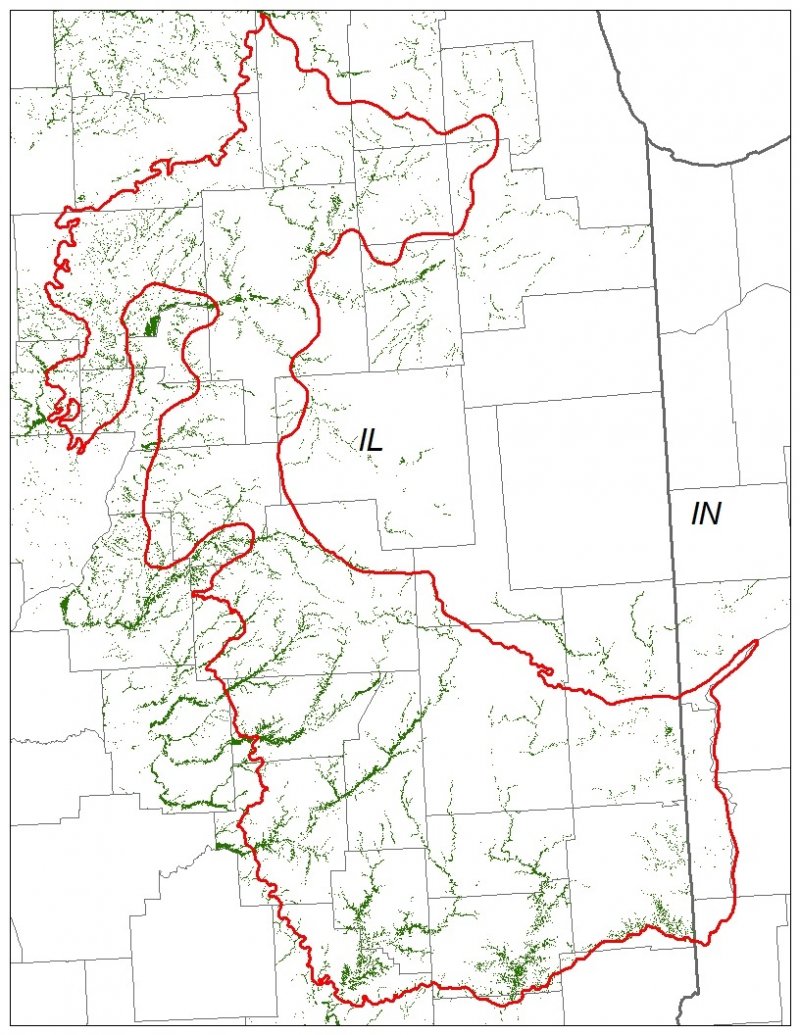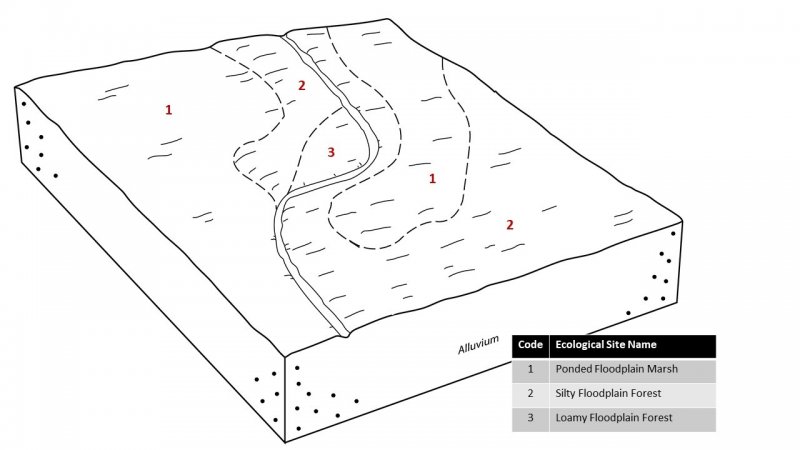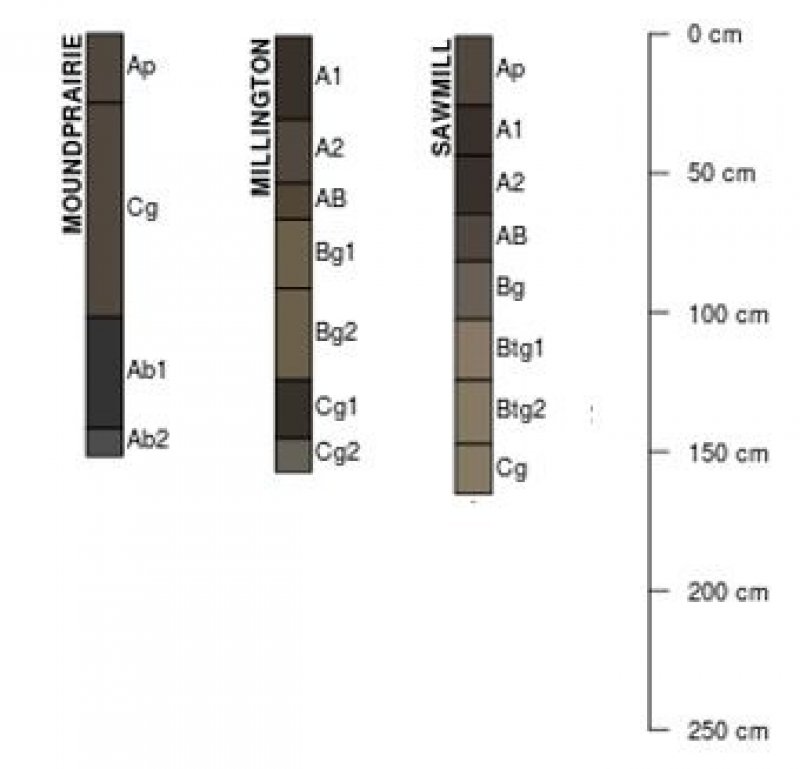Ecological dynamics
The information in this Ecological Site Description, including the state-and-transition model (STM), was developed based on historical data, current field data, professional experience, and a review of the scientific literature. As a result, all possible scenarios or plant species may not be included. Key indicator plant species, disturbances, and ecological processes are described to inform land management decisions.
The MLRA lies within the tallgrass prairie ecosystem of the Midwest. The heterogeneous topography of the area results in variable microclimates and fuel matrices that in turn support prairies, savannas, and forests. Ponded Floodplain Marshes form an aspect of this vegetative continuum. This ecological site occurs on floodplains on very poorly to poorly-drained soils. Species characteristic of this ecological site consist of hydrophytic vegetation.
Flooding and ponding are the dominant disturbance factors in Ponded Floodplain Marshes (LANDFIRE 2009). Seasonal flooding likely occurred annually from spring snow melt and heavy rains. The depth and duration of ponded water affects species diversity, composition, and productivity. Little to no ponded water allows more of a sedge meadow community to dominate, while deep water depths create a shallow to deep marsh community populated with emergent and aquatic vegetation.
Animal herbivory also played a role in shaping this ecological site. Foraging muskrats can alter the extent of emergent vegetation, creating larger patches of open water. Left unchecked, muskrats can remove all the emergent vegetation, which won’t re-establish until the next drought or drawdown event (White and Madany 1978).
Today, Ponded Floodplain Marshes have been greatly reduced as the land has mostly been converted for agricultural production. Remnants that do exist show evidence of indirect anthropogenic influences from hydrological alterations as non-native species have replaced the natural vegetation. A return to the historic plant community may not be possible due to significant hydrologic and water quality changes in the watershed, but long-term conservation agriculture or habitat reconstruction efforts can help to restore some natural diversity and ecological function. The state-and-transition model that follows provides a detailed description of each state, community phase, pathway, and transition. This model is based on available experimental research, field observations, literature reviews, professional consensus, and interpretations.
State 1
Reference State
The reference plant community is categorized as a sedge meadow-marsh community, dominated by hydrophytic vegetation. The three community phases within the reference state are dependent on seasonal flooding and subsequent ponding. The depth and duration of ponding alters species composition, cover, and extent. Animal herbivory has more localized impacts in the reference phases, but does contribute to overall species composition, diversity, cover, and productivity.
Community 1.1
Hairy Sedge - Broadleaf Arrowhead
This reference community phase can occur when the frequency and depth of ponding are reduced to less than 1 foot. Hairy sedge is the dominant monocot, but bulrushes can also be present. Broadleaf arrowhead is still the dominant forb, but forb diversity is greatest in this phase with species such as marsh skullcap (Scutellaria galericulata L.), longroot smartweed (Polygonum amphibium L. var. emersum Michx.), spotted joe pye weed (Eutrochium maculatum (L.) E.E. Lamont), and jewelweed (Impatiens capensis Meerb.) (White and Madany 1978; NatureServe 2018). Shallow ponded water depths (less than 1 foot) will maintain this phase, but an increase in water depths can shift the community to phase 1.2.
Community 1.2
River Bulrush - Broadleaf Arrowhead
Sites in this reference community phase are dominated by hydrophytic herbaceous vegetation. River bulrush and broadleaf arrowhead are the dominant species. Some sites may be dominated by other bulrushes, such as softstem bulrush. Characteristic forbs can include broadfruit bur-reed (Sparganium eurycarpum Engelm.) and American water plantain (Alisma subcordatum Raf.) (NatureServe 2018). Water depths between 1 and 2 feet will maintain this phase, but a reduced water level (below 1 foot) will shift the community to phase 1.1 while an increase in water level (above 2 feet) will shift the community to phase 1.3.
Community 1.3
River Bulrush - Common Duckweed
This reference community phase can occur when the frequency and depth of ponding are greater than 2 feet. Bulrushes and cattails are the dominant monocots. Aquatic vegetation becomes important characteristic species during this phase and can include species such as common duckweed (Lemna minor L.), common duckmeat (Spirodela polyrrhiza (L.) Schleid), and American white waterlily (Nymphaea odorata Aiton ssp. tuberosa(Paine) Wiersma & Hellquist) (NatureServe 2018). Deep ponded water depths (greater than 2 feet) will maintain this phase, but a decrease in water depths can shift the community back to phase 1.1.
Pathway 1.1A
Community 1.1 to 1.2
Ponded water depths increase 12 - 24 inches.
Pathway 1.2A
Community 1.2 to 1.1
Ponded water depths decrease to < 12 inches.
Pathway 1.2B
Community 1.2 to 1.3
Ponded water depths increase to > 24 inches.
Pathway 1.3A
Community 1.3 to 1.2
Ponded water depths decrease to 12 - 24 inches.
State 2
Hydrologically-Altered State
Hydrology is the most important determinant of wetlands and wetland processes. Hydrology modifies and determines the physiochemical environment (i.e., sediments, soil chemistry, water chemistry) which in turn directly affects the vegetation, animals, and microbes (Mitsch and Gosselink 2007). Human activities on landscape hydrology have greatly altered Ponded Floodplain Marshes. Alterations such as agricultural tile draining and conversion to cropland on adjacent lands in addition to stream channelization and damming have changed the natural hydroperiod, increased the rate of sedimentation, and intensified nutrient pollution (Werner and Zedler 2003; Mitsch and Gosselink 2007).
Community 2.1
Reed Canarygrass - Hairy Sedge
This community phase represents the early changes to the natural wetland hydroperiod, increasing sedimentation, and unabated nutrient runoff. Native monocots, such as river bulrush, softstem bulrush, and cattails, continue to form a component of the herbaceous layer, but the highly invasive reed canarygrass (Phalaris arundinaceaL.) co-dominates (Waggy 2010). As reed canarygrass invades, it can not only alter species composition, but vegetation structure as well (Annen et al. 2008). Common reed (Phragmites australis (Cav.) Trin. Ex Steud.) may be a non-native invader in conjunction with or in place of reed canarygrass.
Community 2.2
Reed Canarygrass
Sites falling into this community phase have experienced significant sedimentation and nutrient enrichment and are dominated by a monoculture of reed canarygrass. Reed canarygrass stands can significantly alter the physiochemical environment as well as the biotic communities, making the site only suitable to reed canarygrass. These monotypic stands create a positive feedback loop that perpetuates increasing sedimentation, altered hydrology, and dominance by this non-native species, especially in sites affected by nutrient enrichment from agricultural runoff (Vitousek 1995; Bernard and Lauve 1995; Kercher et al. 2007; Waggy 2010). As in community phase 2.1, common reed may be present, dominant, or monotypic on the site.
Pathway 2.1A
Community 2.1 to 2.2
Continuing alterations to the natural hydrology and increasing sedimentation.
State 3
Forage State
The forage state occurs when the reference state is converted to a farming system that emphasizes domestic livestock production known as grassland agriculture. Fire suppression, periodic cultural treatments (e.g., clipping, drainage, soil amendment applications, planting new species and/or cultivars, mechanical harvesting), hydrologic alterations and grazing by domesticated livestock transition and maintain this state (USDA-NRCS 2003). Early settlers seeded non-native species, such as smooth brome (Bromus inermis Leyss.) and Kentucky bluegrass (Poa pratensis L.), to help extend the grazing season. Over time, as lands were continuously harvested or grazed by herds of cattle, the non-native species were able to spread and expand across the landscape, reducing the native species diversity and ecological function.
Community 3.1
Hayfield
Sites in this community phase consist of forage plants that are planted and mechanically harvested. Mechanical harvesting removes much of the aboveground biomass and nutrients that feed the soil microorganisms (Franzluebbers et al. 2000; USDA-NRCS 2003). As a result, soil biology is reduced leading to decreases in nutrient uptake by plants, soil organic matter, and soil aggregation. Frequent biomass removal can also reduce the site’s carbon sequestration capacity (Skinner 2008).
Community 3.2
Continuous Pastured Grazing System
This community phase is characterized by continuous grazing where domestic livestock graze a pasture for the entire season. Depending on stocking density, this can result in lower forage quality and productivity, weed invasions, and uneven pasture use. Continuous grazing can also increase the amount of bare ground and erosion and reduce soil organic matter, cation exchange capacity, water-holding capacity, and nutrient availability and retention (Bharati et al. 2002; Leake et al. 2004; Teague et al. 2011). Smooth brome, Kentucky bluegrass, and white clover (Trifolium repens L.) are common pasture species used in this phase. Their tolerance to continuous grazing has allowed these species to dominate, sometimes completely excluding the native vegetation.
Community 3.3
Rest-Rotation Pastured Grazing System
This community phase is characterized by rotational grazing where the pasture has been subdivided into several smaller paddocks. Through the development of a grazing plan, livestock utilize one or a few paddocks, while the remaining area is rested allowing plants to restore vigor and energy reserves, deepen root systems, develop seeds, as well as allow seedling establishment (Undersander et al. 2002; USDA-NRCS 2003). Rest-rotation pastured grazing systems include deferred rotation, rest rotation, high intensity – low frequency, and short duration methods. Vegetation is generally more diverse and can include orchardgrass (Dactylis glomerata L.), timothy (Phleum pretense L.), red clover (Trifolium pratense L.), and alfalfa (Medicago sativa L.). The addition of native prairie species can further bolster plant diversity and, in turn, soil function. This community phase promotes numerous ecosystem benefits including increasing biodiversity, preventing soil erosion, maintaining and enhancing soil quality, sequestering atmospheric carbon, and improving water yield and quality (USDA-NRCS 2003).
Pathway 3.1A
Community 3.1 to 3.2
Mechanical harvesting is replaced with domestic livestock utilizing continuous grazing.
Pathway 3.1B
Community 3.1 to 3.3
Mechanical harvesting is replaced with domestic livestock utilizing rotational grazing.
Pathway 3.2A
Community 3.2 to 3.1
Domestic livestock are removed, and mechanical harvesting is implemented.
Pathway 3.2B
Community 3.2 to 3.3
Rotational grazing replaces continuous grazing.
Pathway 3.3B
Community 3.3 to 3.1
Domestic livestock are removed, and mechanical harvesting is implemented.
Pathway 3.3A
Community 3.3 to 3.2
Continuous grazing replaces rotational grazing.
State 4
Cropland State
The continuous use of tillage, row-crop planting, and chemicals (i.e., herbicides, fertilizers, etc.) and hydrologic alterations have effectively eliminated the reference community and many of its natural ecological functions in favor of crop production. Corn and soybeans are the dominant crops for the site, and oats (Avena L.) and alfalfa (Medicago sativa L.) may be rotated periodically. These areas are likely to remain in crop production for the foreseeable future.
Community 4.1
Conventional Tillage Field
Sites in this community phase typically consist of monoculture row-cropping maintained by conventional tillage practices. They are cropped in either continuous corn or corn-soybean rotations. The frequent use of deep tillage, low crop diversity, and bare soil conditions during the non-growing season negatively impacts soil health. Under these practices, soil aggregation is reduced or destroyed, soil organic matter is reduced, erosion and runoff are increased, and infiltration is decreased, which can ultimately lead to undesirable changes in the hydrology of the watershed (Tomer et al. 2005).
Community 4.2
Conservation Tillage Field
This community phase is characterized by rotational crop production that utilizes various conservation tillage methods to promote soil health and reduce erosion. Conservation tillage methods include strip-till, ridge-till, vertical-till, or no-till planting systems. Strip-till keeps seedbed preparation to narrow bands less than one-third the width of the row where crop residue and soil consolidation are left undisturbed in-between seedbed areas. Strip-till planting may be completed in the fall and nutrient application either occurs simultaneously or at the time of planting. Ridge-till uses specialized equipment to create ridges in the seedbed and vegetative residue is left on the surface in between the ridges. Weeds are controlled with herbicides and/or cultivation, seedbed ridges are rebuilt during cultivation, and soils are left undisturbed from harvest to planting. Vertical-till systems employ machinery that lightly tills the soil and cuts up crop residue, mixing some of the residue into the top few inches of the soil while leaving a large portion on the surface. No-till management is the most conservative, disturbing soils only at the time of planting and fertilizer application. Compared to conventional tillage systems, conservation tillage methods can improve soil ecosystem function by reducing soil erosion, increasing organic matter and water availability, improving water quality, and reducing soil compaction.
Community 4.3
Conservation Tillage Field/Alternative Crop Field
This community phase applies conservation tillage methods as described above as well as adds cover crop practices. Cover crops typically include nitrogen-fixing species (e.g., legumes), small grains (e.g., rye, wheat, oats), or forage covers (e.g., turnips, radishes, rapeseed). The addition of cover crops not only adds plant diversity but also promotes soil health by reducing soil erosion, limiting nitrogen leaching, suppressing weeds, increasing soil organic matter, and improving the overall soil ecosystem. In the case of small grain cover crops, surface cover and water infiltration are increased, while forage covers can be used to graze livestock or support local wildlife. Of the three community phases for this state, this phase promotes the greatest soil sustainability and improves ecological functioning within a cropland system.
Pathway 4.1A
Community 4.1 to 4.2
Tillage operations are greatly reduced, crop rotation occurs on a regular interval, and crop residue remains on the soil surface.
Pathway 4.1B
Community 4.1 to 4.3
Tillage operations are greatly reduced or eliminated, crop rotation occurs on a regular interval, crop residue remains on the soil surface, and cover crops are planted following crop harvest.
Pathway 4.2A
Community 4.2 to 4.1
Intensive tillage is utilized, and monoculture row-cropping is established.
Pathway 4.2B
Community 4.2 to 4.3
Cover crops are implemented to minimize soil erosion.
Pathway 4.3B
Community 4.3 to 4.1
Intensive tillage is utilized, cover crop practices are abandoned, monoculture row-cropping is established, and crop rotation is reduced or eliminated.
Pathway 4.3A
Community 4.3 to 4.2
Cover crop practices are abandoned.
State 5
Reconstructed Marsh State
Marsh habitats provide multiple ecosystem services including flood abatement, water quality improvement, and biodiversity support (Mitsch and Gosselink 2007). However, many marsh communities have been eliminated as a result of type conversions to agricultural production, changes to the natural hydrologic regime, and invasion of non-native species, thereby significantly reducing these services (Annen et al. 2008). The extensive alterations of lands adjacent to Ponded Floodplain Marshes may not allow for restoration back to the historic reference condition. But ecological reconstruction can aim to aid the recovery of degraded, damaged, or destroyed functions. A successful reconstruction will have the ability to structurally and functionally sustain itself, demonstrate resilience to the natural ranges of stress and disturbance, and create and maintain positive biotic and abiotic interactions (SER 2002; Mitsch and Jørgensen 2004).
Community 5.1
Early Successional Reconstructed Marsh
This community phase represents the early community assembly from marsh habitat reconstruction and is highly dependent on invasive species control, hydroperiod repair, and planting (Adams and Galatowitsch 2006). In addition, adaptive restoration tactics that incorporate multiple restoration methods should be implemented in order to more clearly identify cause-effect relationships of vegetative development (Zedler 2005).
Community 5.2
Late Successional Reconstructed Marsh
Appropriately timed disturbance regimes (e.g., hydroperiod, invasive species control) and nutrient management applied to the early successional community phase can help increase the species richness and improve ecosystem function, pushing the site into a late successional community phase over time (Mitsch and Gosselink 2007).
Pathway 5.1A
Community 5.1 to 5.2
Maintenance of proper hydrology and nutrient balances in line with a developed wetland management plan.
Pathway 5.2A
Community 5.2 to 5.1
Reconstruction experiences a setback from extreme weather event or improper timing of management actions.
Transition T1A
State 1 to 2
Direct and indirect alterations to the landscape hydrology from human-induced land development transition the site to the hydrologically-altered state (2).
Transition T1B
State 1 to 3
Cultural treatments to enhance forage quality and yield transitions this site to the forage state (3).
Transition T1C
State 1 to 4
Installation of drain tiles, tillage, seeding of agricultural crops, and non-selective herbicide transition the site to the cropland state (4).
Transition T2A
State 2 to 3
Cultural treatments to enhance forage quality and yield transition the site to the forage state (3).
Transition T2B
State 2 to 4
Installation of drain tiles, tillage, seeding of agricultural crops, and non-selective herbicide transition the site to the cropland state (4).
Restoration pathway R2A
State 2 to 5
Hydroperiod restoration, site preparation, non-native species control, and seeding native species transition the site to the reconstructed marsh state (5).
Transition T3A
State 3 to 2
Land is abandoned and left fallow; natural succession by opportunistic species transition this site to the hydrologically-altered state (2).
Transition T3B
State 3 to 4
Installation of drain tiles, tillage, seeding of agricultural crops, and non-selective herbicide transition the site to the cropland state (4).
Restoration pathway R3A
State 3 to 5
Hydroperiod restoration, site preparation, non-native species control, and seeding native species transition the site to the reconstructed marsh state (5).
Transition T4A
State 4 to 2
Agricultural production abandoned and left fallow; natural succession by opportunistic species transition this site to the hydrologically-altered state (2).
Transition T4B
State 4 to 3
Cultural treatments to enhance forage quality and yield transition the site to the forage state (3).
Restoration pathway R4A
State 4 to 5
Hydroperiod restoration, site preparation, non-native species control and seeding native species transition this site to the reconstructed marsh state (5).
Transition T5A
State 5 to 2
Land is abandoned and left fallow; natural succession by opportunistic species transition this site to the hydrologically-altered state (2).
Transition T5B
State 5 to 3
Cultural treatments to enhance forage quality and yield transition the site to the forage state (3).
Transition T5C
State 5 to 4
Installation of drain tiles, seeding of agricultural crops, and non-selective herbicide transition the site to the cropland state (4).





